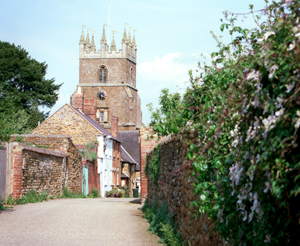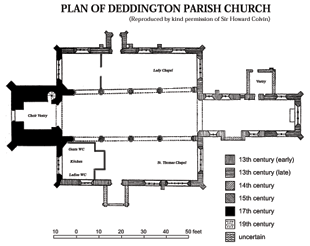Millennium Project
Marianne Elsley
The Parish Church of St Peter and St Paul stands on Deddington ridge and its tower can be seen for many miles around. The church is built of local stone; the original part dates back to the beginning of the 13th century.


Click for PDF file of Plan of Church
At one time, the church had a tall steeple which, with the bell tower, collapsed and crashed into the body of the church in March 1634. Enormous damage was done and the church was not useable for several years. Finally, King Charles I ordered that enough money should be raised by the Diocese to begin the very expensive repair work. The church was rebuilt in the next few years to its present form with a strong tower flanked by massive buttresses and topped with eight splendid gold weather vanes. On the west side of the tower are two statues representing St Peter and St Paul.
The clock was a later addition, a gift of the heirs of William Hudson, a local draper. It has an 18ft pendulum and cost £176 in 1832. It is interesting to note that until 1989 the clock was wound by-hand; someone had to climb to the top of the tower four times a week and crank the heavy winding mechanism. Now there is an electric winder.
The tower contains a set of eight bells*. The original six bells were requisitioned for making weapons by Charles I and were not replaced until 1791. They are rung on Sundays and at practice times, as well as for weddings and funerals. In recent years, the bells needed repairing and enough money was collected locally to have them taken down, the bearings renewed and the bells returned and rehung. In 1991, a country fair was held to commemorate the bicentenary of six of the bells. The other two date from 1946 and were donated by A.J. Morrls to commemorate the Deddington Home Guard. You enter the church by the 19th Century South Porch.
*See also The Church Bells of Oxfordshire by F Sharpe available in the library.
 Just
round to your right in the wall is an opening with stairs, which once
led to a priest's room above the former porch. Moving to the centre of
the church, you pass the kitchen facilities installed towards the end of
the 20th century and turning left, you come to the Font. The 13th
Century font was smashed when the tower fell and the newer one was first
used in 1663. The present one is mid-Victorian; the cover is of a later
date and on both this and the right hand side of the heavy west
doorframe is the carver's trademark of a squirrel. Try and find them!
Just
round to your right in the wall is an opening with stairs, which once
led to a priest's room above the former porch. Moving to the centre of
the church, you pass the kitchen facilities installed towards the end of
the 20th century and turning left, you come to the Font. The 13th
Century font was smashed when the tower fell and the newer one was first
used in 1663. The present one is mid-Victorian; the cover is of a later
date and on both this and the right hand side of the heavy west
doorframe is the carver's trademark of a squirrel. Try and find them!
Moving to the north wall you pass a list of rectors and vicars on a pillar. Opposite the south entrance is another porch. This originates from the 15th Century and was used as an access to the church from the then rectory, the big house at the side of the church. The fan tracery and the domed roof are worth looking at here. To the left of the porch is a meeting room built at the beginning of the 21st century to a design by Oxford Architects.
On the wall near the north porch is a set of wooden battlefield crosses, preserved from the original graves of local men killed during the 1914-18 war and subsequently re-interred by the Commonwealth War Graves Commission. Moving along the north wall near a window you will see a set of stone steps, which are matched, by a similar set on the opposite side of the church. These were the supports for wooden stairs, which at one time led to a second floor. There were several chapels up there until the Reformation, and the upper row of six windows provided the light for them. Moving further along the north wall you will see the Grant of Arms and the much worn monument of William Billing who died in 1533. The Lady Chapel has two stained-glass windows (1928 and 1936) designed by the artist A.J. Davies. One shows the Virgin Mary with Hannah and St George and the other Christ and the Children. A brass fixed to the wall depicts the upper part of a bearded man of Edward Ill's reign. Moving along to the chancel you will come to the screen, heavily restored but containing some 15th Century workmanship. The chancel is narrow compared with the main body of the church and the floor has been raised, so that the piscina on the right appears unusually low in the wall. The stained-glass east window was made in 1888 by C.E. Kempe, one of the best known artists in that medium of his day. The choir stalls date from 1865. The organ was built in 1912 by J.J. Binns of Leeds. Its casing was designed by Hare and made by Franklins of Deddington. In the sanctuary you will see three 13th Century sedilia (priest's seats) with carved capitals.
 Turning
back, you will face the main body of the church, large and spacious
with wide aisles, columns and arches. Even so, the church was not large
enough for the congregation in the early l9th century when a vicar
called Richard Greaves filled the church to overflowing. A gallery was
put up at the west end to seat more people. One of the worshippers at
that time was the Oxford student John Henry Newman, later Cardinal
Newman. The gallery was taken down at a later date. The pulpit and the
lectern were made at the turn of the century by the Franklin family of
Deddington. The kneeling desk has some interesting carving on one side.
Try to find the cat and the Green Man!
Turning
back, you will face the main body of the church, large and spacious
with wide aisles, columns and arches. Even so, the church was not large
enough for the congregation in the early l9th century when a vicar
called Richard Greaves filled the church to overflowing. A gallery was
put up at the west end to seat more people. One of the worshippers at
that time was the Oxford student John Henry Newman, later Cardinal
Newman. The gallery was taken down at a later date. The pulpit and the
lectern were made at the turn of the century by the Franklin family of
Deddington. The kneeling desk has some interesting carving on one side.
Try to find the cat and the Green Man!
On the east end of the south wall is St Thomas's Chapel and beneath is a vaulted charnel house. The altar was given by Dr. Maurice Frost who was Vicar of Deddington 1924-1961.
 Coming
back to the southwall you will see the effigy of a local 14th Century
lawyer called Ralph de Beriford or Barford. On the same wall on the
other side of the porch is the splendid family memorial of the Harris
family, which has three hedgehogs on the crest. Mr. Harris was a
Deddington butcher who became famous for his pork sausages and pies. You
are now back at the south porch. On each side of the entrance are what
little remains of the first 13th Century walls.
Coming
back to the southwall you will see the effigy of a local 14th Century
lawyer called Ralph de Beriford or Barford. On the same wall on the
other side of the porch is the splendid family memorial of the Harris
family, which has three hedgehogs on the crest. Mr. Harris was a
Deddington butcher who became famous for his pork sausages and pies. You
are now back at the south porch. On each side of the entrance are what
little remains of the first 13th Century walls.
Those of you who are interested in needlework will want to see the new Mothers' Union banner which was designed by Amanda Gray and worked by the Deddington Craft Group. It was dedicated in 1992. Please also look at the beautiful altar frontal made with gold and silver leather. It depicts the keys associated with St Peter and the sword of St Paul and was donated in 1991 by Mrs. Sheila Reece. You may also like to see the Deddington panel, which was made by local needlewomen. It hangs in the Library.